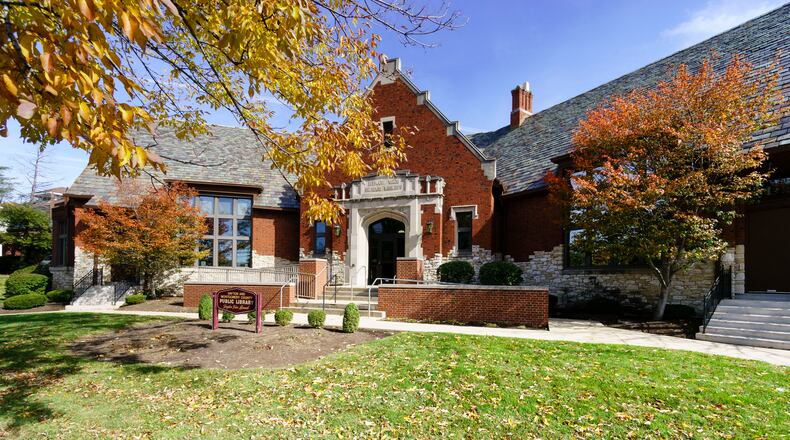I grew up at that library and will never forget the happy hours I spent there. My yellow library card was beloved and well-worn, and I was proud of the little stars attached to it by my favorite librarian, the kind Mrs. Marianna Riesner who was the children’s librarian at Dayton View Branch in the 1950s.
When my own sons were small, we made that library one of our regular stops, attending the children’s programs and story hours.
Credit: HANDOUT
Credit: HANDOUT
This revered library officially closed on March 30, 2016, when the beautiful new Northwest branch opened at the corner of Philadelphia Drive and Hillcrest Avenue, replacing the Dayton View, Fort McKinley and Northtown-Shiloh branches. According to Dayton Metro Library executive director Tim Kambitsch the building has since been used for staff offices but staffers are relocating to the new downtown library slated to open Aug. 5.
The Dayton View library building is for sale for $249,000. Library officials say they’ll work with potential buyers on the price if they have plans to maintain the integrity of the building.
Kambitsch says the library did get its Landmark Status. “We have a plaque for the building, but more importantly the exterior is protected,” he says. ” I would work on the price if the next owner has plans for the integrity of the building’s interior or if a non-profit or government agency would have some public good behind their use of the building.”
>> Why this library is architect’s favorite building
ABOUT THE ARCHITECT
Credit: HANDOUT
Credit: HANDOUT
Bement, an architect and principal with the local firm App Architecture, has lived in the Dayton View Triangle neighborhood with his family for the past 20 years in a restored Spanish Eclectic stucco home built in 1930. Tim is a former member of the Dayton View Triangle Community Development Board and he and his wife Ami, an interior designer, have restored three additional homes in their neighborhood, attracting new neighbors to the community.
He is a past president of the AIA Dayton Chapter and currently serves as President of the Board of Vandalia Youth Theatre, where both of his teenagers are active participants.
>> Looking at the Kuhn’s Building Downtown through a new lens
Credit: HANDOUT
Credit: HANDOUT
Here’s what Bement writes about the history and architecture of his favorite building:
The beautiful Dayton View Branch Library opened to the public in September 1930 and was designed by Dayton architect Albert Pretzinger. The Pretzinger family of architects and engineers left an architectural legacy in the region — from commercial buildings to places of worship to schools and movie theaters. The footprint of the library building makes the best use of its triangular shaped plot of land at the corner of Salem and Wabash avenues.
The English Tudor Revival architecture features red brick and Bedford stone with a slate roof, as well as dramatic cathedral ceilings with exposed and masterfully carved heavy timber structure inside. The open, flowing floor plan lends itself nicely to the specific use for which it was designed. The building today looks much the same as it did over 85 years ago, which is a testament of wonderful stewardship by the library system.
Credit: HANDOUT
Credit: HANDOUT
Tudor Revival style (also known as Tudorbethan) residences and public buildings were extremely popular in the 1920s and 1930s after certain aesthetics of the Arts and Crafts Movement in previous decades had spread from the United Kingdom to the United States. Simplicity in building materials taken from nature and an emphasis on artisan craftsmanship were two of the main tenets of the style. Decorative half-timbering infilled with stucco or brick walls, tall ornamental chimneys, elaborate brickwork, steeply pitched slate roofs with gables, stone-surrounded entries and patterned leaded glass windows added Old World charm and nostalgia to buildings of this time period. Magazines and house plan catalogs of the era contributed to the spread in popularity of the picturesque and romanticized English revival styles around the country.
Since the library was designed as a true neighborhood branch when most people walked or took the trolley or bus to visit, off-street parking was not a high priority. Hence, the lack of parking may be considered a challenge as the building awaits a new user.
Perhaps to preserve an architectural treasure such as this, we need to come together as a community of creative thinkers and invent a new use that continues to benefit the Salem Avenue corridor.
Architectural Treasures
Architecture is art. In this periodic series, arts writer Meredith Moss invites architects in our region to select one of their favorite buildings in the Miami Valley and tell us why they find it so special.
>> Taking a look at our region's Architectural Treasures
The series is presented in cooperation with AIA Dayton, an organization founded in 1900 as a chapter of the American Institute of Architects. Today it serves as the voice of the architecture profession in the Miami Valley. AIA Dayton serves a nine-county area and is involved numerous community outreach programs, including a design lecture series and scholarships for students pursuing studies in architecture. Find out more at aiadayton.org.
The Architectural Treasures series is a past recipient of the Dayton Builders Exchange’s President’s Award.
>> This Dayton Daily News reporter gets exactly what she deserves
Credit: HANDOUT
Credit: HANDOUT
About the Author






